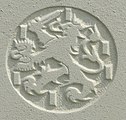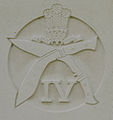Rheinberg War Cemetery
The Rheinberg War Cemetery is a war cemetery that was established by the Commonwealth War Graves Commission (CWGC) after the Second World War in April 1946 and is still under their protection and care. The military cemetery was established in April 1946 near Rheinberg in the Lower Rhine Plain between Wesel and Moers .
Occupancy
Of the total of 3,334 buried, the majority belonged to the Luftwaffe , the victims were transferred from Düsseldorf , Krefeld , Mönchengladbach , Goch , Lingen and Cologne to this new cemetery. They are dead who lost their lives during the battles in the Rhineland. The nationalities who fell were: Great Britain , Canada , Australia , New Zealand , Poland , South Africa , India , United States . There are also 156 tombstones for unknown victims.
The nationalities in detail:
- 2,458 British
- 516 Canadians
- 240 Australians
- 104 New Zealanders
- 8 Poland
- 5 South Africans
- 1 Indian
- 1 American
- 1 unknown nationality
As listed on the plaques in the cemetery.
layout
The military cemetery was built according to the plans of the architect Philip Dalton Hepworth . Its architectural structure is based on the building regulations of the CWGC and shows the basic characteristics of all these cemeteries. In the so-called Heroes' Hall, a large plaque bears the inscription "This area was made available by the German people as a permanent resting place and as a tribute to the fallen seamen, soldiers and aviators". The cemetery fits in nicely with the tranquil landscape.
overview
Viewed from the entrance area, the unobstructed view allows a general overview of the area. Its center is the altar stone with the inscription "Their Name Liveth For Evermore" and the large sacrificial cross with sword . In the background the cemetery is delimited by a hall of honor with a colonnade, on the two stone tablets the dead are paid homage and thanks to the German people for providing this area. Two tower-like buildings are reminiscent of watchtowers , one tower commemorates the military units and the other tower building keeps the cemetery register.
Tombstones
The white sand-lime stone tombstones were laid on either side of the wide lawn between the high cross and the altar stone. There is no classification according to origin or rank , on all stones the unit , the name with rank, indirectly the religious affiliation ( in the form of a cross or Star of David , if known) and a memorial verse from the relatives (if desired) is engraved. In addition to the name and the date of death, all tombstones also show the rank, soldier number, age, rank and the symbol of the armed forces.
Horticultural design
The tombstones are at ground level and placed on small beds . The entire area is criss-crossed with lawns, there are no delimiting paths or hedges on the symmetrically laid out area, the total area forms a large unit and symbolizes the equality of all victims.
See also
Web links
Individual evidence
- ↑ http://verwehte-spuren.de.tl/Rheinberg.htm Annex created in April 1946
Coordinates: 51 ° 31 ′ 47 " N , 6 ° 33 ′ 49" E






